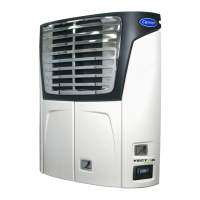7–37 62-11785
00125 CHECK COMP DISCHARGE SENSOR
• ACTIVATION: Compressor Discharge Temperature Sensor (CDT) is not within the range of -40° to
+392°F (-40° to +200°C).
• UNIT CONTROL: Alarm Only.
• RESET CONDITION: Auto reset when sensor is in range or, alarm may be manually reset using the dis-
play mounted keys or by turning the unit off, then back on again.
NOTE: Follow the steps below until a problem is found. Once a repair or correction has been made, the active
alarm should clear itself (refer to reset condition above). Operate the unit through the appropriate modes to see
if any active alarm occurs. Continue with the steps below as necessary.
CORRECTIVE ACTIONS:
1. Check Sensor
a. Inspect sensor & connector. Verify there is no damage to sensor, and no damage, moisture, or
corrosion in connector.
b. Check sensor resistance. (Refer to Note 3 in Notes Section.) 90,000 Ohms @ 77°F (25°C). Refer
to Table 8–4 for chart of resistances for different sensors.
2. Check Sensor Wiring
a. Inspect connector pins & terminals 2MM. (See wiring schematic Section 10.3.) Verify there is no
physical damage to harness, and no damage, moisture, or corrosion in connectors.
b. Place the system in PC Mode. Refer to Note 2 in Notes Section. Disconnect sensor from harness.
Check for 3.0 ± 0.1 VDC volts at harness plug between pins. This verifies microprocessor output
and wiring connections to the sensor.
00127 CHECK SUCTION TEMP SENSOR
• ACTIVATION: Compressor Suction Temperature Sensor (CST) is not within the range of -53 to +158°F
(-47 to +70° C.)
• UNIT CONTROL: Alarm only. Control of Superheat will switch to supply air temperature sensor.
• RESET CONDITION: Auto reset or alarm may be manually reset using the display mounted keys or by
turning the unit off, then back on again.
NOTE: Follow the steps below until a problem is found. Once a repair or correction has been made, the active
alarm should clear itself (refer to reset condition above). Operate the unit through the appropriate modes to see
if any active alarm occurs. Continue with the steps below as necessary.
CORRECTIVE ACTIONS:
1. Check Sensor
a. Inspect sensor & connector. Verify there is no damage to sensor, and no damage, moisture, or
corrosion in connector.
b. Check sensor resistance (refer to Note 3 in Notes Section). 10,000 Ohms @ 77°F (25°C.) See
Table 8–3 for complete table of temperatures and resistance values.
2. Check Sensor Wiring
a. Inspect connector pins & terminals at sensor and connector 2MM. (See wiring schematic Section
10.3.) Verify there is no physical damage to harness, and no damage, moisture, or corrosion in
connectors.
b. Place the system in PC Mode. Refer to Note 2 in Notes Section. Disconnect sensor from harness.
Check for 3.0 ± 0.1 VDC volts at harness plug between pins. This verifies microprocessor output
and wiring connections to the sensor.

